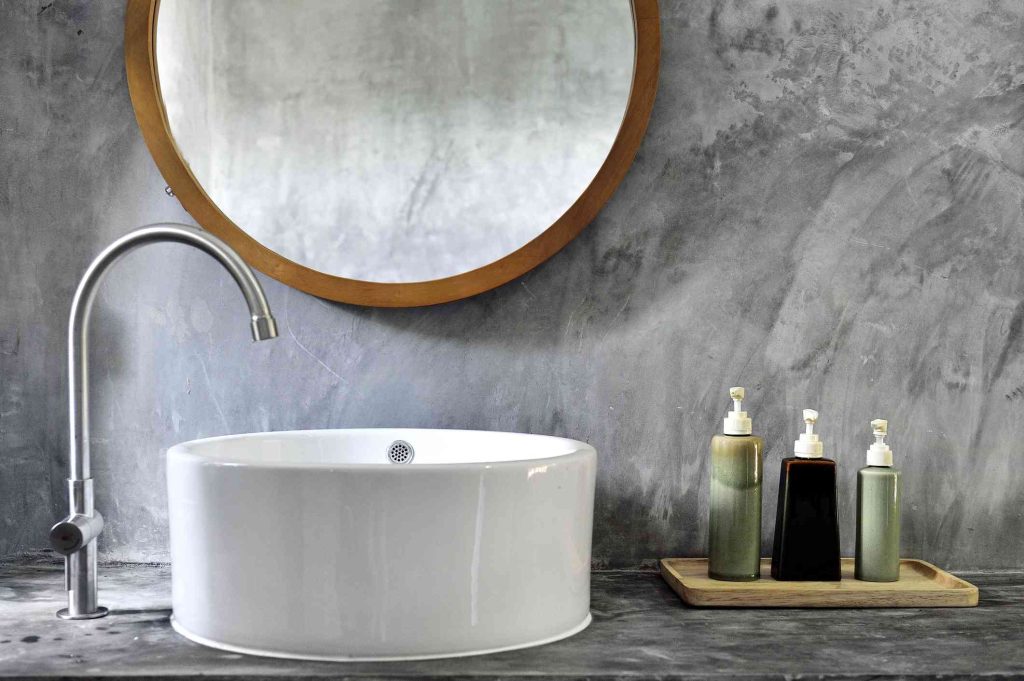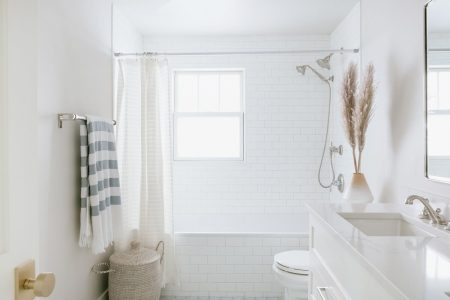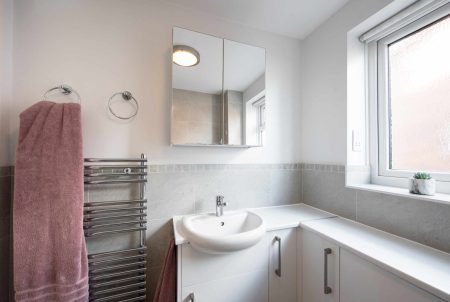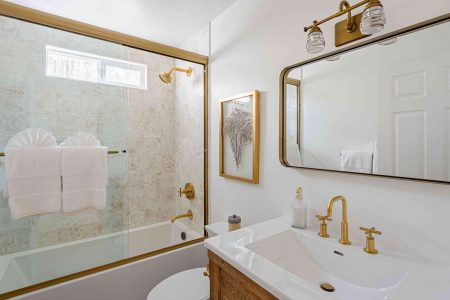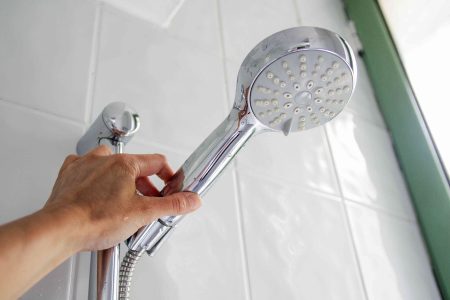Bathroom vanity cabinets are a staple of many homes. These compact multi-purpose units store bathroom essentials in drawers, hide cleaning products, and of course, act as a base for the bathroom vanity top and sink. You’ll find innumerable vanity tops available for purchase that fit your vanity cabinet. Another way to add a countertop is to pour your own concrete vanity top.
If the project sounds far-fetched, it’s anything but. For any do-it-yourselfer with a creative bent, making a concrete vanity top is fun and low-cost—plus you’ll have a counter that you truly can call your own.
Basics of Pouring a Perfect Concrete Vanity Top
Form the Concrete Upside-Down
Many of those immaculately smooth concrete countertops you see in high-end kitchens are made with a secret: an upside-down concrete form. Professional concrete technicians are adept at pouring upright countertops and smoothing the surface with trowels. But another way they achieve a glass-smooth finish is by pouring the concrete into an upside-down concrete form. The form’s perfectly flat bottom, sides, and beveled edges are transferred to the concrete vanity top, with very little post-molding work required.
Reinforce the Concrete
Concrete has excellent compressive strength but poor tensile strength. Concrete technicians embed metal rebar mesh inside of the concrete to improve its strength. As a do-it-yourselfer, you can do this, too. Home centers sell small sections of rebar mesh that are perfect for making concrete vanity tops. The mesh is easy to cut with a hacksaw.
Vibrate the Concrete
Poured concrete contains voids that can partially be eliminated by pushing the concrete around. Vibrating the mixture helps to force trapped air out, resulting in a denser, stronger countertop. Tapping the form with a rubber mallet or a hammer can do this. You can use any tool around your shop that vibrates, such as a sander, or you can rent a small electrically operated concrete vibrator for a day or two from a local rental yard.
Safety Considerations
Concrete is heavy. The volume of the concrete in this project is about .66 cubic feet or 100 pounds. Lift the vanity top and form with a partner. After you release the vanity top from the form, watch out of the edges. Even though you rounded down the edges in advance, some razor-sharp parts will remain. Wear gloves when handling the vanity top.
What You’ll Need
Equipment / Tools
- Rubber mallet or orbital sander (for vibrating the concrete)
- Hacksaw
- Glue gun
- Tape measure
- Spring clamps
- Garden hoe
- Resin mixing tub
- Cordless drill
- Orbital sander
- Sandpaper
- Marker
- Circular saw
- Miter saw
- Table saw
- Speed Square
- Paint roller and several roller covers
- Bevel tool
- Latex gloves
- Caulking gun
- Straight edge razor blade
- Eye, hearing, and breathing protection
- Shop vacuum
- Utility knife
- Masonry trowel
- Rags
- Spray bottle filled with water
- Sheet plastic
- Hose
- Latex gloves or substitute
Materials
- 2 bags of countertop concrete mix, 60 pounds each
- Melamine-faced medium-density fiberboard (MDF) panel, common thickness 3/4-inch
- Rebar sheet mesh, flush cut
- Coarse thread drywall or specialty particleboard screws, 1 5/8-inch
- Concrete sealer
- Beeswax
- Silicone caulk, black or another dark color
- Mineral oil
- Scrap two-by-four
- Portland cement
- Acrylic cement fortifier
Instructions
-
Measure the Cabinet and the Sink
With the tape measure, measure the width and depth of the sink cabinet from the top (with no countertop). If you intend to install a new sink, a paper or cardboard cut-out may be included to help you mark out the dimensions of the sink. If the faucet and controls come up through holes on the sink, you will not need to add holes to the concrete vanity top.
-
Build the Vanity Top Template
Countertop templates are pieced together from thin strips of wood or cardboard. This helps the countertop conform to any wall or cabinet variations.
On the base cabinet, lay out strips of cardboard or 1/8-inch thickness wood project panel and glue them together with the glue gun to create a template for the perimeter of the vanity top.
-
Draw the Vanity Top Shape on the Form
Lay the vanity top template on top of a melamine-faced medium-density fiberboard (MDF) panel, common thickness 3/4-inch. If the back side of the template is straight, then place it against one of the factory-cut sides of the board. Make sure there is space around the other three sides of the template. Clamp down the template. With the marker, draw the vanity top shape on the board. Also draw the sink cut-out.
-
Cut the Bottom of the Form
Use the circular saw to cut the concrete form along the lines that you drew on the board. To cut perfectly straight lines, you may want to use a saw guide. Do not cut out the sink cut-out.
-
Cut and Build the Sidewalls
Strips of melamine board that rise 2 inches from the bottom of the form will act as sidewalls to create a container for the wet concrete. With the bottom of the form on a table and the melamine side facing up, lay the sidewall material against the sides of the form. The edges of sidewall material must rest on the table.
Measure up 2 inches from the bottom of the form and mark the cut point with the marker. Use the circular saw to rip four sidewalls, one wall for each side of the form.
Screw the sidewalls to the sides of the concrete form bottom with the screws. Check for square with the Speed Square and adjust as needed.
-
Cut and Build Sink Sidewalls
Cut strips of melamine board 2 inches wide. Piece these together and cut as necessary to form the shape of the sink cut-out. Attach to the form bottom from below with screws. Keep this cut-out square with the Speed Square.
-
Bevel the Edges
By adding silicone caulk to all of the 90-degree joints and then rounding the caulk, you create the reverse appearance after the counter is released from the form. The reverse is a rounded, or eased, edge. Caulk also prevents the concrete mix from seeping through the seams between the sidewalls and the form bottom.
Put on a pair of latex gloves. Squirt silicone caulk into all of the 90-degree inner joints on the form. Then, use a marble, the end of a glue stick, a ball bearing, or any round or circular item, and draw the item through the caulk. Wetting the item with water will help it move through the caulk without sticking.
Do not overwork the bevel. Aim to draw through the caulk just one time, if possible. Two parallel rows of caulk will form on the sides of the bevel bead. Do not wipe these off since you will be able to remove them later.
-
Clean the Excess Silicone
Let the silicone dry for at least two hours. Once the silicone is fully cured, peel off any excess with your fingers. You can also use the straight razor or a loose utility knife blade to carefully remove the silicone.
-
Cut the Rebar Mesh
Use the hacksaw to cut the rebar mesh to 1 inch less than the size of the vanity top. Be sure to cut out the center area for the sink.
-
Add Oil to the Form
Melamine is used for the inside of the form because concrete does not stick well to it. Even so, it helps to add mineral oil to the inside of the form to help the form and the cured concrete to release from each other. Apply the oil liberally with cotton rags but do not allow the oil to pool up.
-
Mix and Pour the Concrete
Put on latex gloves and breathing protection. Cut open the bag of concrete and pour it into the mixing tub. Mix in the amount of water as recommended by the manufacturer. With the hoe, mix the concrete and water.
Pour the concrete into the form. Avoid the center sink cut-out; this does not receive concrete. Push the concrete around the form by hand, making sure that it reaches all edges and corners. Use the paint roller to push the concrete around and downward. Pour the concrete up only halfway for now.
-
Add the Rebar Mesh
With the concrete halfway in the form, add the rebar mesh. Push it down firmly into the concrete. Use the paint roller to press it down even further.
-
Vibrate the Form
Vibrating the concrete form eliminates holes and other voids, especially those that develop on the bottom of the form and on the edges. Tapping the form with a rubber mallet helps to settle the concrete. If you have any type of vibrating tool such as a sander or a hammer drill, you can use these, too.
-
Screed the Concrete
Have one person continue to add mixed concrete on top of the rebar, as the other person vibrates the form. Once the concrete reaches the top of the form, use a scrap piece of two-by-four to screed off the top of the concrete.
What Is Screeding?
Screed means to level off the top of wet concrete by moving a board back and forth while pulling it toward you. This is only a rough, initial leveling; smoother leveling comes later.
-
Trowel the Concrete
Immediately after screeding, use the masonry trowel to smooth down the concrete. A smooth top (later to become the bottom) will help the vanity top seat better on the vanity cabinet.
-
Cure the Concrete
Lightly mist the concrete with water from the spray bottle, then cover it with sheet plastic. Keep it out of the sun to slow the curing process. Concrete that dries quickly is more likely to crack and break. Let the concrete cure for at least three days. Keep the concrete lightly damp during this process.
-
Remove the Form
Use the drill to remove the screws that hold the form together. If you can, pull the sidewalls off of the vanity top by hand. If you cannot, lightly tap it off with a rubber mallet. With a helper, turn the concrete vanity top over with the bottom of the form still attached. Pry the form off of the top of the vanity top.
-
Sand the Edges
The silicone bevels go a long way toward smoothing down the vanity top’s edges. But some sharp lines will still remain. Use an orbital sander with 220 grit sandpaper to take off these lines.
-
Sand the Vanity Top
Sand the top of the concrete vanity top with the orbital sander. Work up to a sandpaper grit of #320. If, along the way, you encounter voids, fill them in with a mixture of Portland cement and acrylic fortifier.
-
Seal the Vanity Top
After thoroughly cleaning the vanity top, apply a minimum of four coats of sealer. Each coat should dry completely before you move to the next coat. Finish with countertop beeswax or equivalent.
Tips for Making a Concrete Vanity Top
- Always work with a partner, not just for lifting assistance but to keep the concrete from hardening on you.
- For better access when building the form, work on a table, not on the ground.
- When you pour the concrete, the form must be on a perfectly flat and level surface. Check with a bubble level.
- Set a timer to remind yourself to regularly mist the concrete after the pour.
Read the full article here







